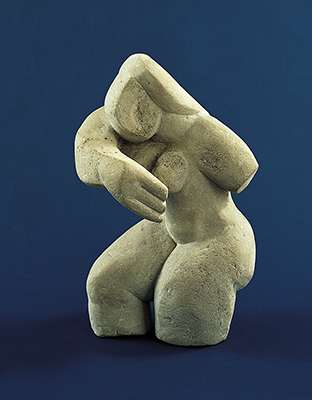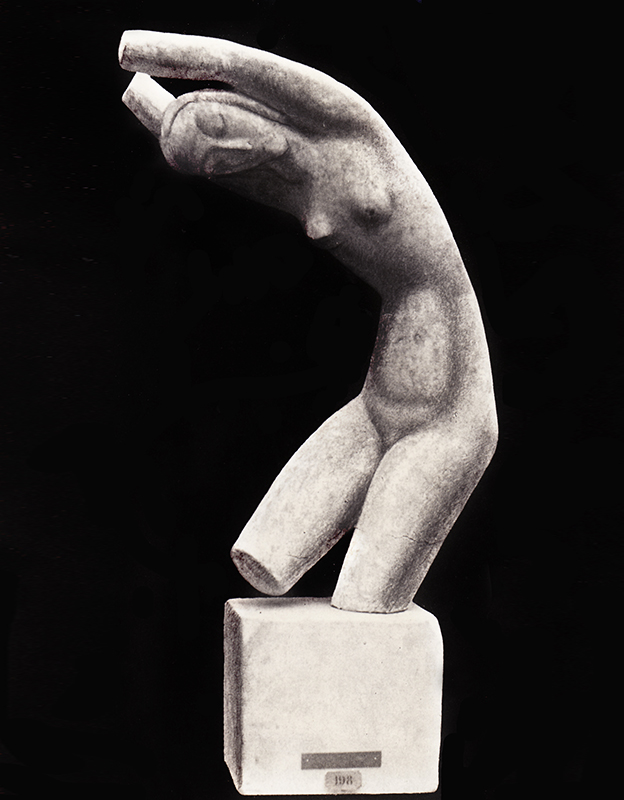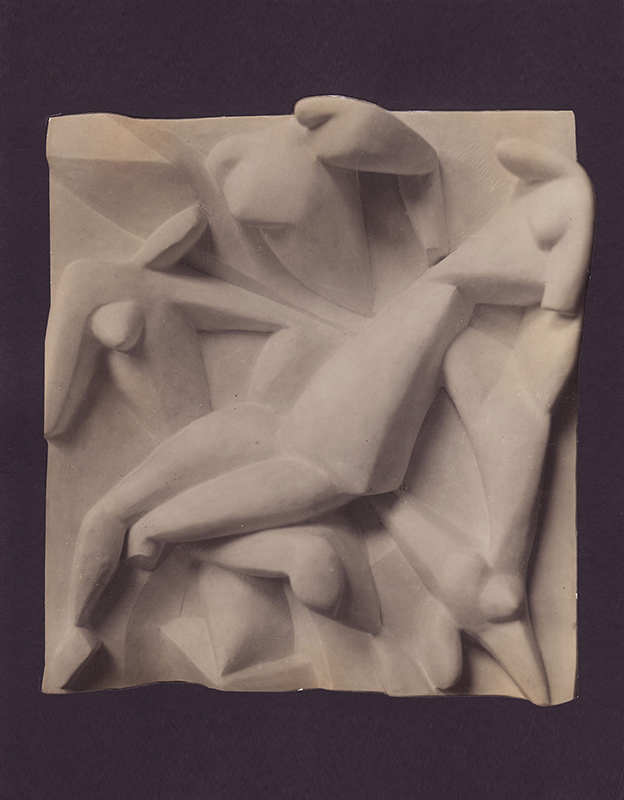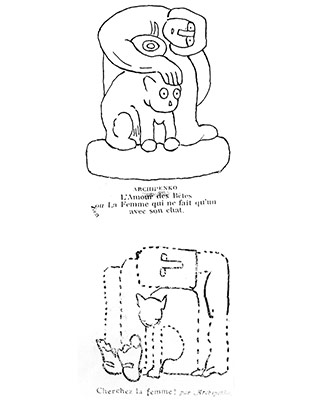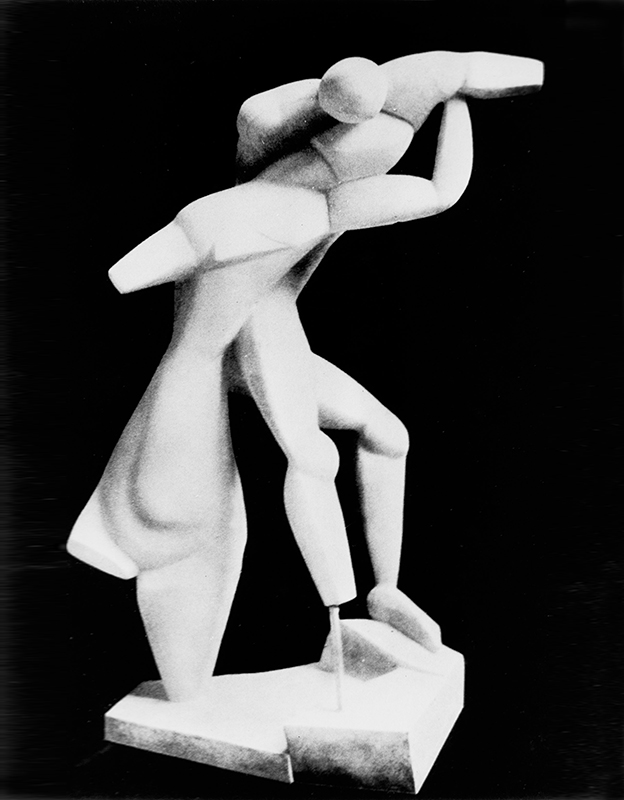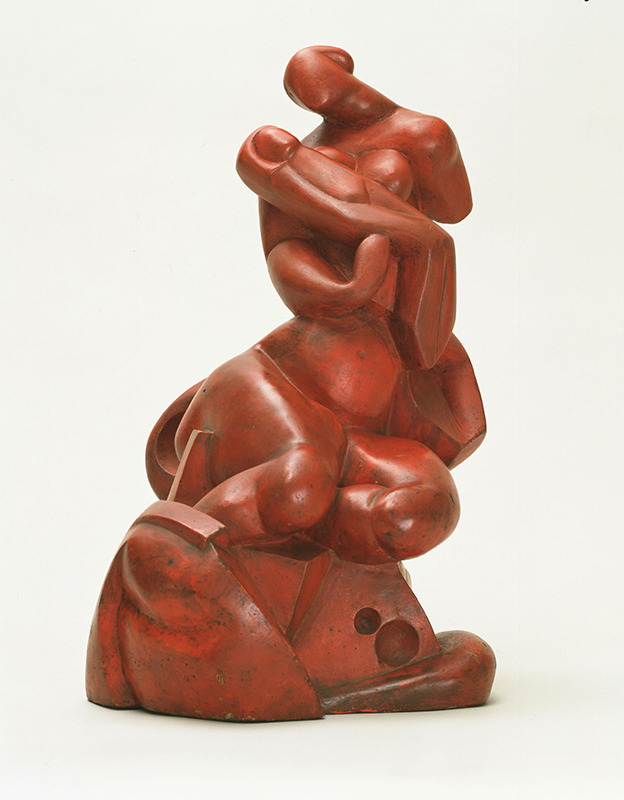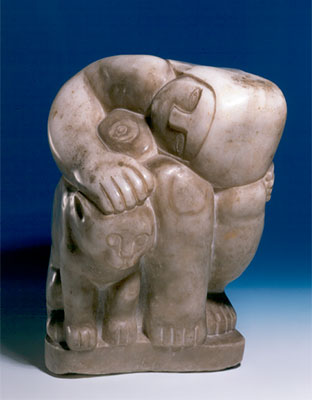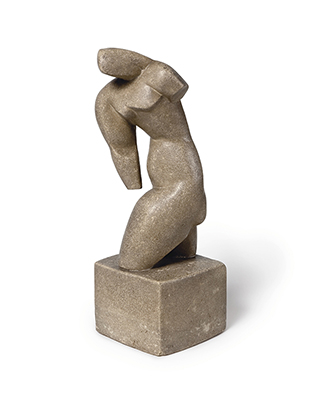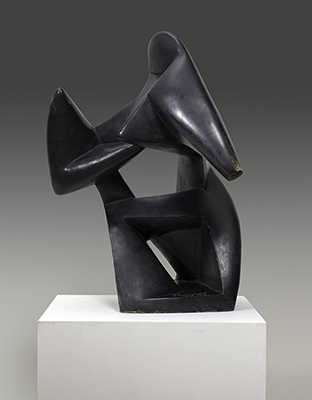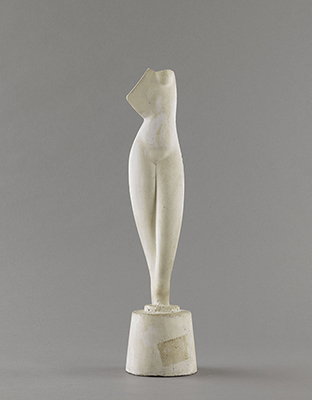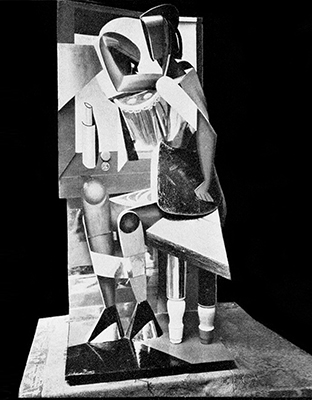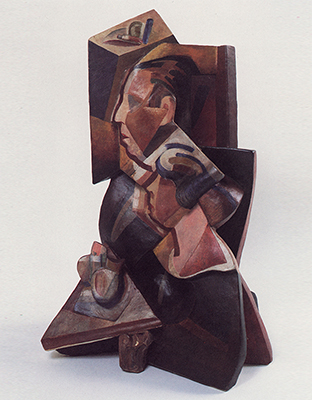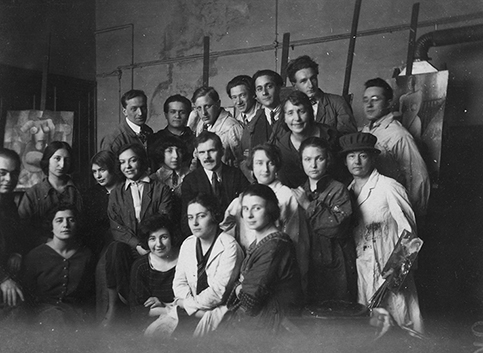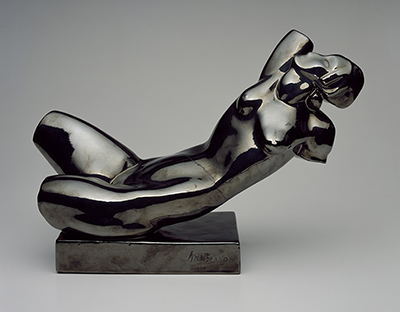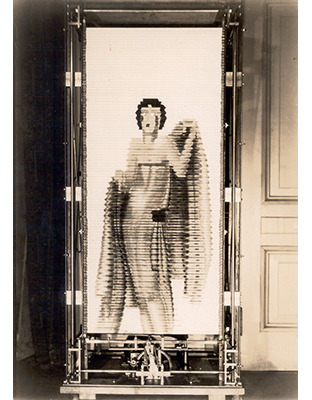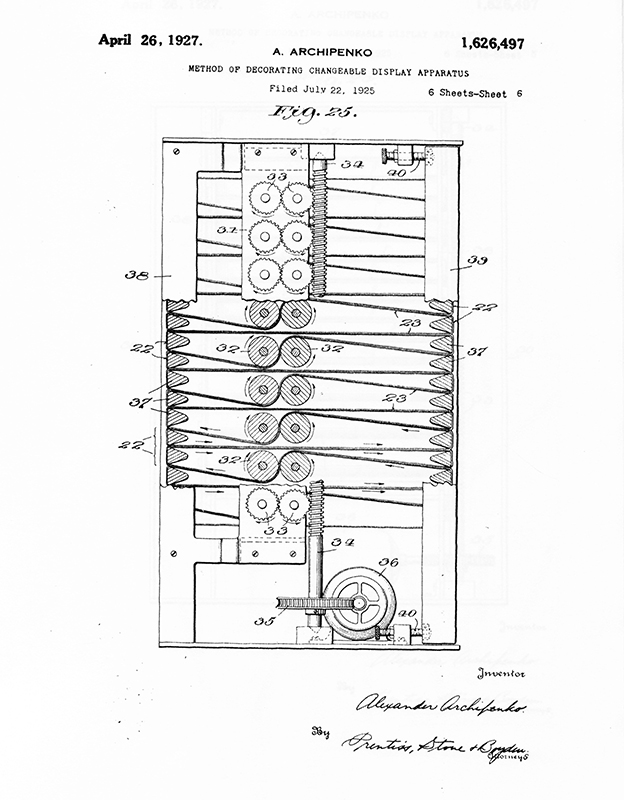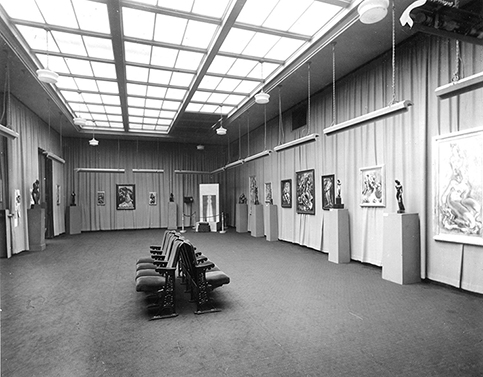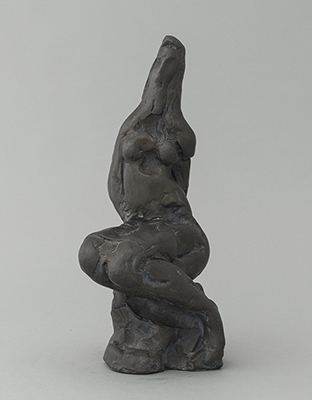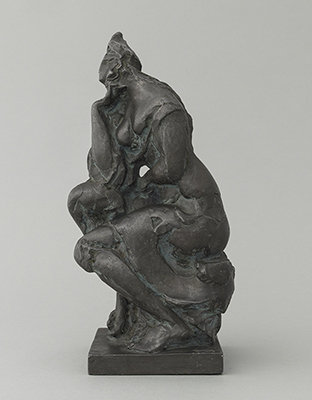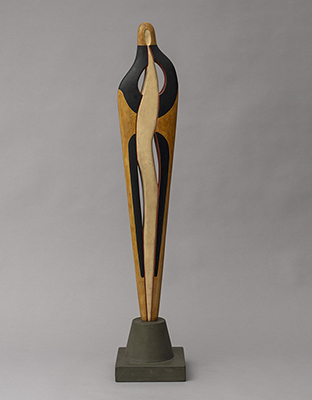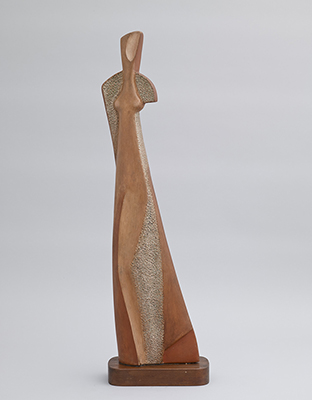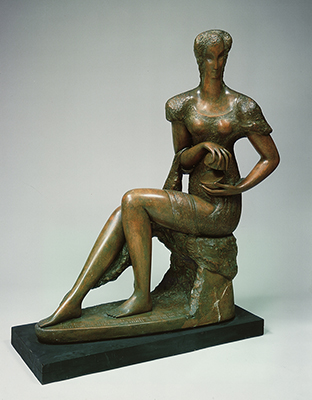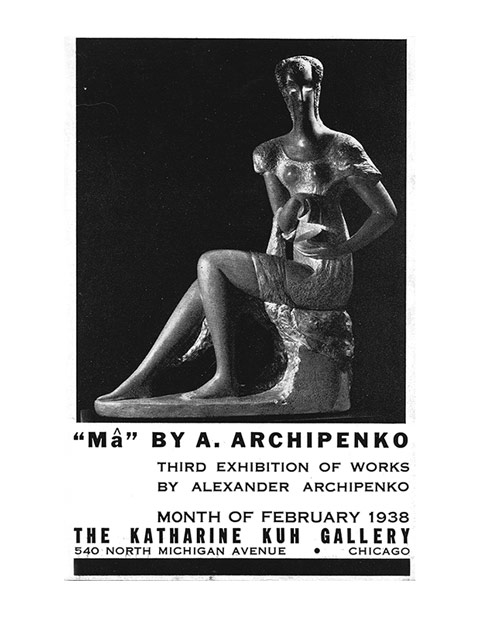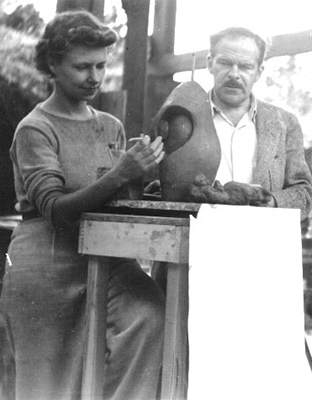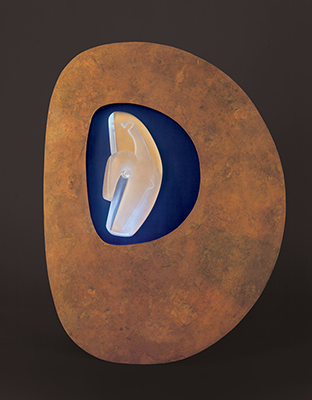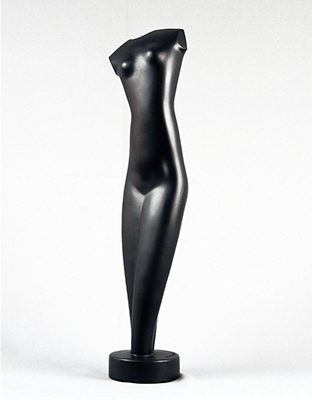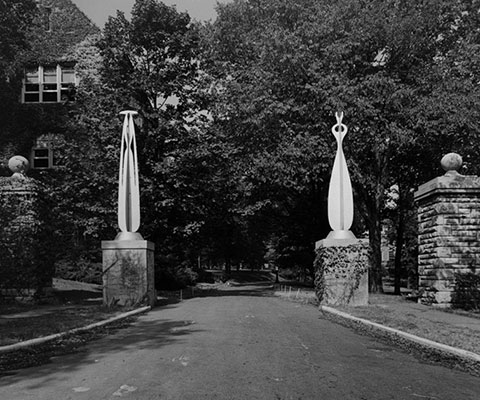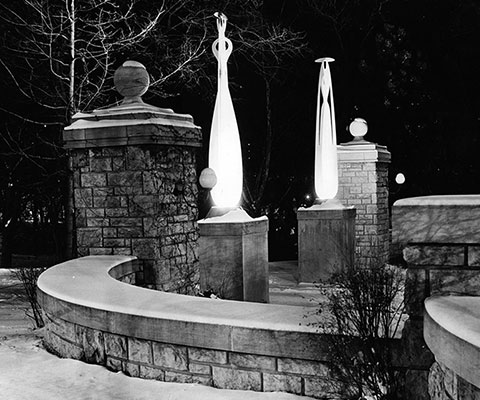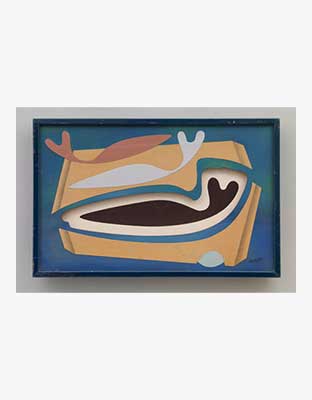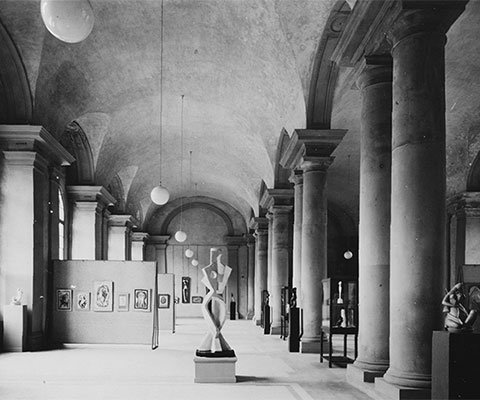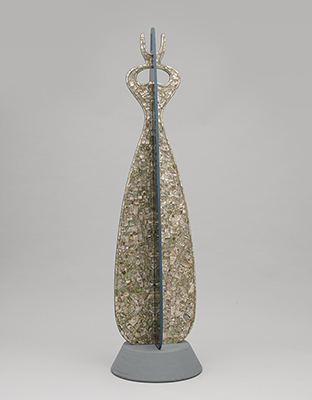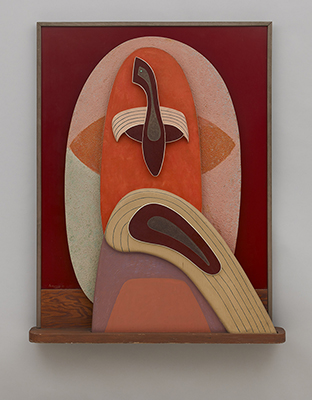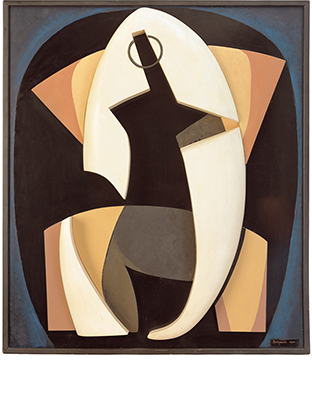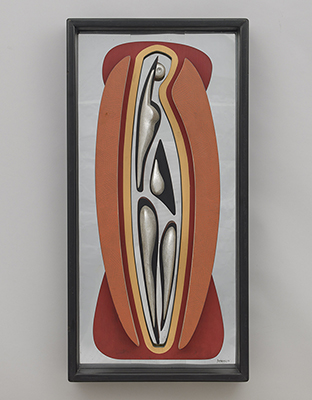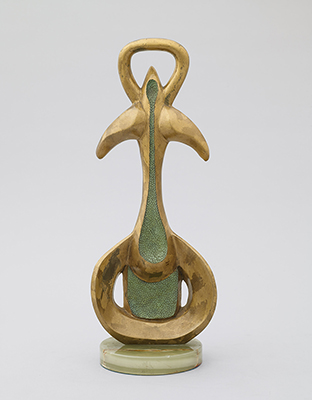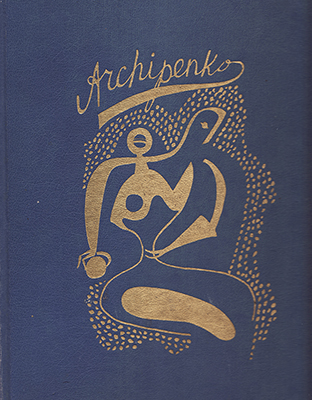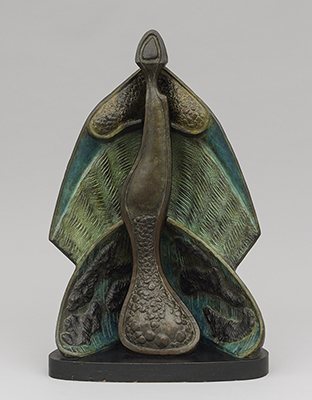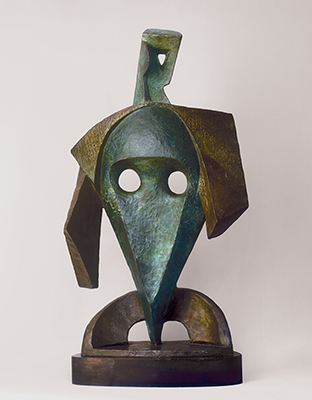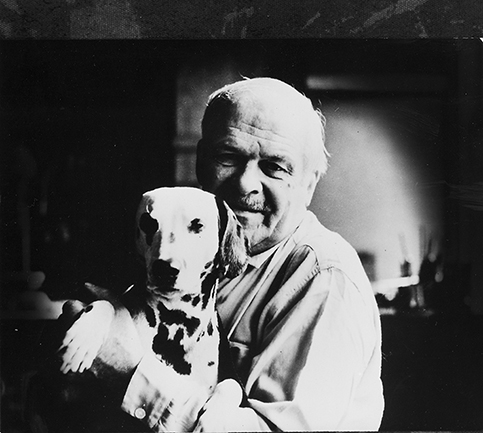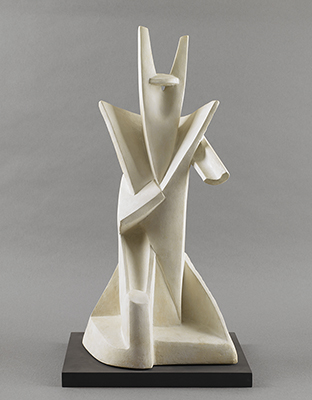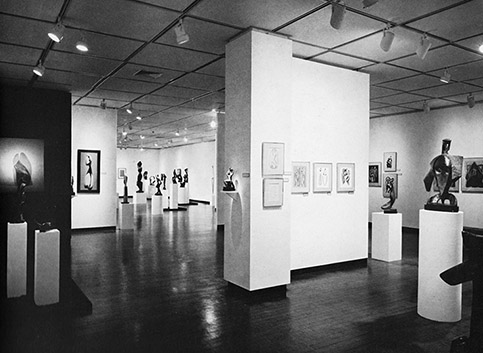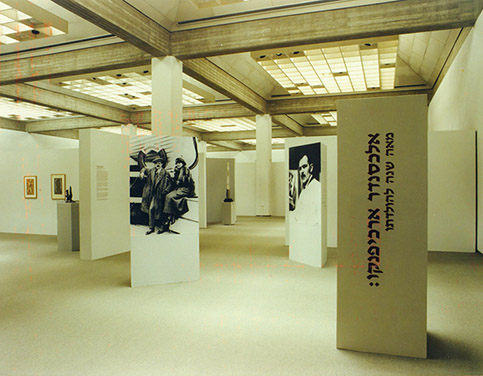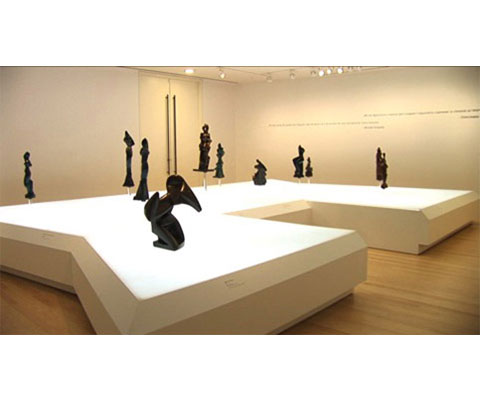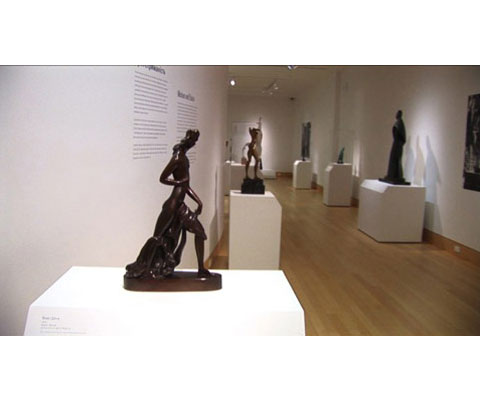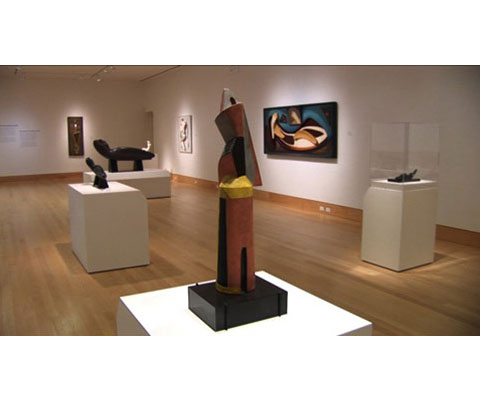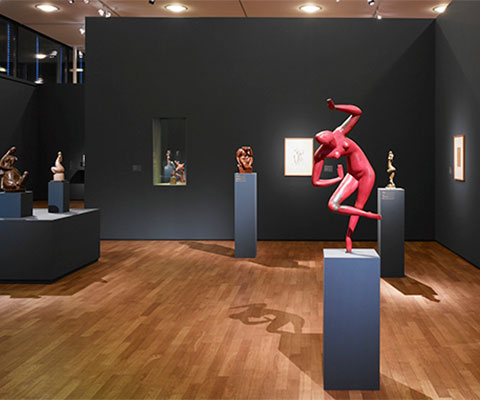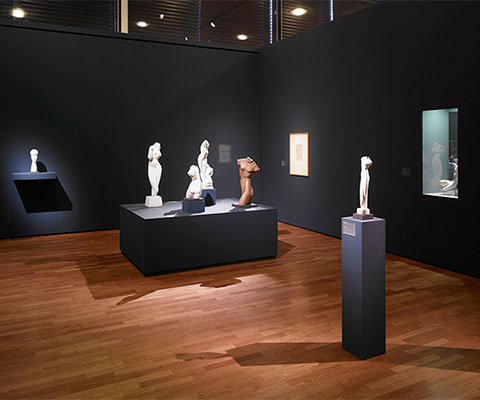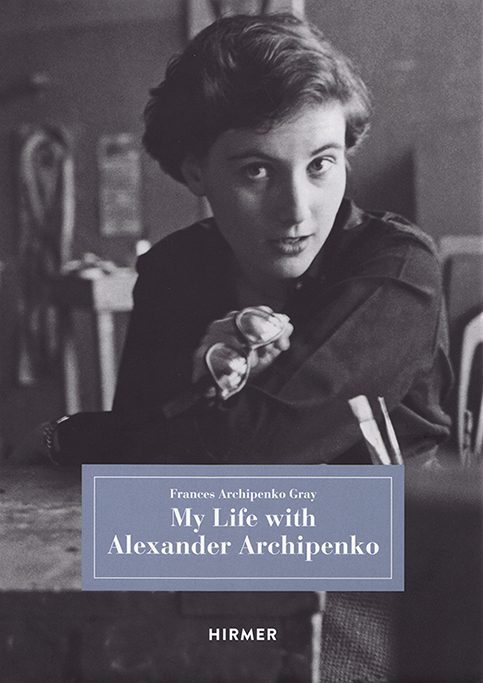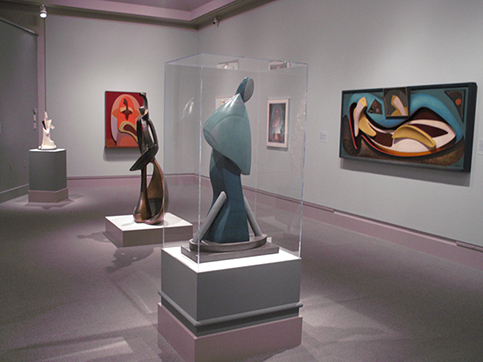Alexander Archipenko in his Berlin studio, circa 1921
Arrives in Paris. Finds the Ecole des Beaux-Arts too academic and leaves after approximately two weeks for independent study at the Louvre and other Parisian museums.
Establishes an independent studio at Montparnasse. Frequents the artists’ colony La Ruche where he meets Modigliani, Léger, Apollinaire, Cendrars, Gaudier-Brzeska and Raynal.
-
Sorrow (La Tristesse), 1909
Image by Lee Stalsworth for The Ukrainian Museum in New York for the exhibition catalog Alexander Archipenko: Vision and Continuity
Catalogue Raisonné -
Woman (Sadness, Head on Knee), 1909
Image courtesy of Stiftung Saarländischer Kulturbesitz, Saarlandmuseum Saarbrücken
Catalogue Raisonné -
Suzanne, 1909
Image courtesy of the Norton Simon Museum
Catalogue Raisonné
First public exhibition in Paris at the Salon des Indépendants with Cubists, including Delaunay, Duchamp, Duchamp-Villon, Le Fauconnier, Gleizes, Léger, Lhote and Metzinger. He also takes part in the Salons of 1911, 1912, 1913, 1914, and 1920.
Frequents the Duchamp brothers’ salons.
-
Salome (Dancer), 1910
Image courtesy of The Archipenko Fundation
Catalogue Raisonné -
Sketch for Ceiling, 1910-1913
Image courtesy of The Archipenko Foundation
Catalogue Raisonné -
The Kiss 1910
Image courtesy of The Archipenko Foundation
Catalogue Raisonné
Shows with Cubists at the Salon des Indépendants and the Salon d’Automne.
Review of Salon d’Automne caricatures Woman With Cat.
-
Published in an unidentified French newspaper at the occasion of the Salon d’Automne, Paris, 1911
Image courtesy of The Archipenko Foundation
Catalogue Raisonné -
The Kiss (Recherche plastique), 1911
Image courtesy of The Archipenko Foundation
Catalogue Raisonné -
Maternity (La Mère dans les Roches), 1911-1912
Digital image © The Museum of Modern Art/Licensed by SCALA/Art Resource, NY.
Catalogue Raisonné -
Woman With Cat, 1910-1911
Image courtesy of Museum Kunst Palast, Düsseldorf
Catalogue Raisonné
Opens art school in Paris.
Boccioni who arrived in Paris in 1911, visits Archipenko in his studio.
Creates Médrano I, a sculpture with movable parts and constructed of various materials: wood, glass, and metal wire.
Shows at the Salon des Indépendants and the Salon d’Automne.
Shows in La Section d’Or, Galerie La Boétie, Paris.
Solo show at Museum Folkwang, Hagen, Germany. Apollinaire writes an introduction for the exhibition catalog.
-
Medrano (Medrano I), 1912
Image courtesy of The Archipenko Foundation
Catalogue Raisonné -
Dance, 1912-1913
Image courtesy of The Archipenko Foundation
Catalogue Raisonné -
Two Bodies, 1912
Image courtesy of The Archipenko Foundation
Catalogue Raisonné
Shows at the Salon des Indépendants.
Shows at the Armory Show in New York.
Galerie Der Sturm: “17. Ausstellung: Alexander Archipenko,” catalog foreword by Apollinaire.
-
Porteuse, 1912
© Christie's Images Limited, New York, 11/1/2011.
Catalogue Raisonné -
Family Life, 1912
Image courtesy of The Archipenko Foundation
Catalogue Raisonné
Shows at the Mánes Fine Arts Association in Prague, along with Brancusi and Duchamp-Villon.
Solo show in Halle, Germany, organized by Der Sturm.
Shows at the Salon des Indépendants. Apollinaire publishes a review in L’Intransigeant (March 2, 1914): “Le Salon des Indépendants.”
Shows at the Esposizione Libera Futurista Internazionale in Rome.
Creates first sculpto-paintings. Develops sculptural elements of color, the void, concave and convex, and geometric forms further.
“Archipenko challenged the traditional understanding of sculpture. It was generally monochromatic at the time. His pieces were painted in bright colors. Instead of accepted materials such as marble, bronze or plaster, he used mundane materials such as wood, glass, metal, and wire. His creative process did not involve carving or modeling in the accepted tradition but nailing, pasting and tying together, with no attempt to hide nails, junctures or seams. His process parallels the visual experience of cubist painting.”
-Juan Gris
August 1: Germany declares war against France and Russia. Many artists leave Paris and move to the South of France. Archipenko spends the war years (1914 - 1918) in Cimiez, near Nice, at Château Valrose. The group of artists living in Nice includes Ferat, Tsuguharu Foujita, Henri Matisse, Amedeo Modigliani, Morgan Russel, Chaim Soutine and Leopold Survage.
-
Carrousel Pierrot, 1913
Image courtesy of the Solomon R. Guggenheim Museum, New York
Catalogue Raisonné -
Blue Dancer, 1913
Image courtesy of Stiftung Saarländischer Kulturbesitz, Saarlandmuseum Saarbrücken
Catalogue Raisonné -
Medrano II Dancer, 1913-1914
Image courtesy of the Solomon R. Guggenheim Museum, New York
Catalogue Raisonné -
Boxers, 1913-1914
Image courtesy of the Solomon R. Guggenheim Museum, New York
Catalogue Raisonné -
Flat Torso, 1914
Image courtesy of Stiftung Saarländischer Kulturbesitz, Saarlandmuseum Saarbrücken
Catalogue Raisonné -
Woman in Front of Mirror, 1914
Image courtesy of The Archipenko Foundation
Catalogue Raisonné -
In the Boudoir, 1915
The Philadelphia Museum of Art/ Art Resource NY.
Catalogue Raisonné
Develops La Vie Humaine, a cubist play.
Correspondence with Theo van Doesburg, De Stijl Group.
Blaise Cendrars dedicates his poem “La tête” to Archipenko.
-
Vase Woman, 1918
Image courtesy of Hirshhorn Museum and Sculpture Garden, Smithsonian Institution, Washington DC; image courtesy of The Archipenko Foundation
Catalogue Raisonné
Sally Falk acquires Archipenko’s work.
Marthe Donas becomes a close friend.
Shows in “Exhibition of French Art 1914 - 1919,” Mansard Gallery, Heal & Son, Ltd., London.
Spends time in Nice working on sculpto-paintings, which he presents the following year at the Salon des Indépendants.
November: Marcel Duchamp brings Katherine Dreier to Archipenko’s studio.
“Tournée de l’exposition de sculptures, sculpto-peintures, peintures, dessins de Alexandre Archipenko,” opens in Geneva, Switzerland. Traveling to other locations in Zurich, Paris, London, Amsterdam, Brussels, Dresden, Munich, Düsseldorf and New York.
-
Portrait of Mr. and Mrs. Falk, 1919
Image courtesy The Tel Aviv Museum of Art
Catalogue Raisonné -
Standing Woman, 1919
Image courtesy of The Phillips Collection, Washington DC
Catalogue Raisonné -
Kneeling Woman, 1918-1919
Image courtesy The Tel Aviv Museum of Art
Catalogue Raisonné
Shows in the last Cubist group exhibition at Salon des Indépendants.
Solo show at Venice Biennale, Russian Pavillion, “Mostra Individuale di Alexandre Archipenko.”
Shows in La Section d’Or, in Paris, Geneva, Brussels, Rome, and Rotterdam, The Hague, Amsterdam.
Opens art school in Berlin, also keeps his studio in Paris.
Marries Angelica Forster (1893 - 1957), a German sculptor who exhibits under the name Gela Forster. She is a founding member of “Group 1919” of the Dresdner Sezession.
Verlag Ernst Wasmuth, Berlin publishes lithograph portfolio Dreizehn Steinzeichnungen.
"Archipenko," Société Anonyme, New York, organized by Katherine Dreier and Marcel Duchamp.
Publication of “Archipenko Album,” a monograph with texts by Ivan Goll and Theodor Däubler and the poem “La Tête” by Blaise Cendrars.
-
Standing Woman, 1921
Image courtesy of The Archipenko Foundation
Catalogue Raisonné
Shows in “Erste Russische Kunstausstellung,” Galerie van Diemen, Berlin.
Solo shows in Germany at Galerie Fritz Gurlitt, Berlin and Kunstsalon Ludwig Schames, Frankfurt.
-
Reclining Torso, 1921-1922
Image courtesy of the Brooklyn Museum
Catalogue Raisonné -
Portrait of Artist’s Wife, 1922
Image courtesy of The Archipenko Foundation
Catalogue Raisonné -
Reclining, 1921-1922
Image courtesy of Alexander Gray Associates
Catalogue Raisonné
Solo shows at Leipziger Kunstverein, Leipzig.
Angelica and Alexander Archipenko emigrate to the USA. They arrive in New York on board the S.S. Mongolia on October 16.
“America is the only country not jaded and rent by war. It is the land where the great art of the future will be produced. America fires my imagination more than any other country and embodies more of that flexibility, that yeastiness, which means life and vitality and movement.”
–Alexander Archipenko, 1923
Opens art school in New York.
Receives patents for “Archipentura”, an "Apparatus for Displaying Changeable Pictures and Method for Decorating Changeable Display Apparatus."
-
Archipentura, 1924
Image courtesy of The Archipenko Foundation
Catalogue Raisonné -
Archipentura, 1924
Image courtesy of The Archipenko Foundation
Catalogue Raisonné -
Patent for Archipentura, 1927
Image courtesy of The Archipenko Foundation
Catalogue Raisonné -
Patent drawing for Archipentura, 1927
Image courtesy of The Archipenko Foundation
Catalogue Raisonné
Purchase of 13 acres of land on rock quarry site in Bearsville, near Woodstock, New York.
Becomes American citizen.
Establishes “Arko,” a school of ceramics in New York City.
“An Exhibition of Sculpture and Paintings,” The Arts Club, Chicago.
“The Archipenko Exhibition,” Braxton Gallery, Hollywood. Josef von Sternberg purchases 18 works from the exhibition.
-
Standing Woman, 1924
Image courtesy of private collection
Catalogue Raisonné -
Bust of a Woman, 1929
© Sotheby's New York, 2/12/2009
Catalogue Raisonné
Solo show at Braxton Galleries, Hollywood, “The Archipenko Exhibition.”
Solo show, Renaissance Gallery, Montecito, California.
-
Diagonal (Sketch), 1931
Image courtesy of private collection
Catalogue Raisonné -
Seated Girl (Sketch), 1931
Image courtesy of private collection
Catalogue Raisonné -
Melancholy, 1931
Image courtesy of private collection
Catalogue Raisonné
Solo show at John Levy Galleries, New York City.
Lectures on creativity at universities and colleges on Pacific Coast, Midwest and the East Coast.
Teaches at Mills College, Oakland, California and at the Chouinard School, Los Angeles.
Shows 44 works, including the Mâ-series at the Ukrainian Pavilion at the World Fair “A Century of Progress.” His narrative “M” is reproduced in the exhibition catalog.
Moves to Los Angeles.
Teaches summer sessions at University of Washington, Seattle. Read.
-
Family Life (Fragment), 1935
Image courtesy of private collection
Catalogue Raisonné -
Vertical Figure, 1935
Image courtesy of private collection
Catalogue Raisonné -
Josephine Bonaparte, 1935
Image courtesy of private collection
Catalogue Raisonné
Lives in Chicago. Invited by László Moholy-Nagy to teach at the New Bauhaus Chicago as head of Modelling Workshop.
“The credit for the first conscious use of concaves in sculpture – to replace saliences – is due to Archipenko... His attempt leads the observer, by its evident deviation from the customary naturalistic treatment, to a realization of the elementary possibilities of the positive-negative relations.”
– László Moholy-Nagy, 1932.
Solo show at Katherine Kuh Gallery, Chicago.
Germany, Nazis confiscate works by Archipenko as “Degenerate Art.”
-
The Bride, 1936
Image courtesy of Seattle Art Museum, Eugene Fuller Memorial Collection.
Catalogue Raisonné -
Ma Meditation, 1937
Image courtesy of private collection
Catalogue Raisonné
Opens “Modern School of Fine Arts and Practical Design” in Chicago.
Opens art school in Bearsville.
Solo show at Katherine Kuh Gallery, Chicago.
-
Seated Figure, 1938
Image courtesy of private collection
Catalogue Raisonné -
Yellow and Black, 1938
Image courtesy of Los Angeles County Museum of Art
Catalogue Raisonné -
Small Diagonal Torso, 1938
Image courtesy of The Archipenko Foundation
Catalogue Raisonné
Solo show at Katherine Kuh Gallery, Chicago.
Creates Moses, a seven-foot high sculpture, to benefit artists exiled by the Fascist regimes in Europe.
Solo show at University of Omaha. The exhibition travels to Springfield Museum of Art and Philadelphia Art Alliance.
-
Moses, 1939
Image courtesy of The Archipenko Foundation
Catalogue Raisonné
Shows in “We like Modern Art”, Museum of Modern Art, New York.
Solo show at Katherine Kuh Gallery, Chicago.
Solo show at Katherine Kuh Gallery, Chicago.
Teaches summer art school in Bearsville.
-
Tartar Woman, 1942
Image courtesy of private collection
Catalogue Raisonné -
Black and White Dancer, 1942
Image courtesy of private collection
Catalogue Raisonné -
Espagnol (Spanish Woman), 1942
Image courtesy of private collection
Catalogue Raisonné
Teaches at Dalton School, New York.
Solo show at Nierendorf Gallery, New York.
Teaches summer art school in Bearsville.
Returns to Chicago, teaches at the Institute of Design (formerly Bauhaus).
Creates Seated Figure, his first carved plastic sculpture illuminated from within. Moholy-Nagy recounts later that Archipenko invents his own machine at the Bauhaus to carve plastic.
Returns to Chicago, teaches at the Institute of Design (formerly Bauhaus).
“In teaching I make my students realize the necessity of applying the psychological process for the discovery of creative reactions within themselves before they make the form which should contain creative power. This is a fundamental knowledge that vitalizes the work of art.”
–Alexander Archipenko
Teaches summer art school in Bearsville.
-
Seated Figure, 1947
Image by Petro Hrycyk for The Ukrainian Museum in New York for the exhibition catalog Alexander Archipenko: Vision and Continuity.
Catalogue Raisonné -
The Moon, 1947
Image by Petro Hrycyk for The Ukrainian Museum in New York for the exhibition catalog Alexander Archipenko: Vision and Continuity
Catalogue Raisonné
Shows new acrylic glass works at Associated American Artists Galleries, New York.
-
Torso, 1948
Image courtesy of Forum Gallery, New York
Catalogue Raisonné
First exhibition after the war in Europe at Amt für Kunst, Berlin, Germany.
“Colored Drawings of Archipenko,” Seattle Art Museum, exhibition travels to Palace of the Legion of Honor, San Francisco.
“Alexander Archipenko,” University of Nebraska, Omaha.
Shows in Annual Exhibition at the Whitney Museum of American Art, New York.
Teaches at University of Missouri in Kansas City.
Commissioned to create two statues for the entrance of the University of Missouri. The two identical “Iron Figures,” 14-foot high constructions with crossing planes, were completed in 1951. Read
-
Iron Figure, 1951
Image courtesy of University of Missouri at Kansas City, MO
Catalogue Raisonné -
Iron Figure, 1951
Image courtesy of University of Missouri at Kansas City, MO
Catalogue Raisonné
Shows in “American Sculpture”, The Metropolitan Museum of Art.
Teaches at Carmel Art Institute, California, at the University of Washington, Seattle, and at the University of Delaware.
Shows in Annual Exhibition at the Whitney Museum of American Art, New York.
Shows in “L’Oeuvre du XXe siècle, Peintures, Sculptures,” Musée National D’Art Moderne, Paris, exhibition travels to The Tate Gallery, London, “XXth Century Masterpieces.”
Shows in “Sculpture of the Twentieth Century,” Philadelphia Museum of Art, exhibition traveled to The Art Institute of Chicago, January 22 – March 8, 1953, and to The Museum of Modern Art, April 29 – September 7, 1953.
“Desenhos de Archipenko,” Museum of Modern Art, Sao Paulo, Brazil.
Elected Associate Member of International Institute of Arts and Letters.
Shows in “Le Cubisme,” Musée National d’Art Moderne, Paris.
-
Collage (Torso), 1953
Image courtesy of private collection
Catalogue Raisonné
Retrospective “Archipenko 110th Exhibition, Fifty Years Production,” Associated American Artists Galleries, New York
-
Birth of Venus, 1954 (bronze cast 1958)
© Sotheby's New York, 11/7/2013
Catalogue Raisonné -
Venus, 1954
Image courtesy of private collection
Catalogue Raisonné -
Queen, 1954
Image courtesy of private collection
Catalogue Raisonné -
Torso (Collage), 1954
Image courtesy of The Archipenko Foundation
Catalogue Raisonné
Large traveling retrospective in Germany, Hessisches Landesmuseum Darmstadt, Städtische Kunsthalle Mannheim, Kunsthalle Recklinghausen.
-
Installation view of the traveling retrospective Alexander Archipenko Plastik Malerei Zeichnungen Druckgraphik, Hessisches Landesmuseum Darmstadt, 1955
Image courtesy of The Archipenko Foundation
Catalogue Raisonné -
Installation view of the traveling retrospective Alexander Archipenko Plastik Malerei Zeichnungen Druckgraphik, Städtische Kunsthalle, Recklinghausen, 1955
Image courtesy of The Archipenko Foundation
Catalogue Raisonné
Traveling retrospective in Germany continues, Städtische Kunstsammlung Düsseldorf, Kunstverein Freiburg, Charlottenburger Schloss, Berlin.
Teaches at University of British Columbia, Vancouver, Canada.
Shows in Annual Exhibition at Whitney Museum, New York.
-
Revolving Figure, 1956
Image courtesy of private collection
Catalogue Raisonné
“Archipenko: Recent Polychromes,” Perls Galleries, New York. Catalog with foreword by Alexander Archipenko. Read.
On December 5 his wife Angelica dies at the age of 65, after a long illness.
-
Cleopatra, 1957
Image by Petro Hrycyk for The Ukrainian Museum in New York for the exhibition catalog Alexander Archipenko: Vision and Continuity
Catalogue Raisonné -
Red, 1957
Image courtesy of private collection
Catalogue Raisonné -
Ballerina, 1957
Image courtesy of The Archipenko Foundation
Catalogue Raisonné -
White, 1957
Image by Petro Hrycyk for The Ukrainian Museum in New York for the exhibition catalog Alexander Archipenko: Vision and Continuity
Catalogue Raisonné -
Oval Figure, 1957
Image by Petro Hrycyk for The Ukrainian Museum in New York for the exhibition catalog Alexander Archipenko: Vision and Continuity
Catalogue Raisonné -
Multicolored Figure, 1957
Image courtesy of private collection.
Catalogue Raisonné
“Alexander Archipenko: Bronzes,” Perls Galleries, New York.
Awarded Medaglia d’Oro at XIIIa Biennale d’Arte Trivenata, IIIo Concorso Internazionale del Bronzetto, Salla della Ragione, Padua, Italy.
-
Fragmentary Relief, 1959
Image courtesy of private collection
Catalogue Raisonné -
Eagle, 1959
Image courtesy of private collection
Catalogue Raisonné -
Statuette, 1959 (bronze cast 1961)
Image courtesy of private collection
Catalogue Raisonné
Publishes his book “Archipenko: Fifty Creative Years, 1908-58."
Traveling exhibition in Germany, Karl-Ernst-Osthaus-Museum Hagen, Saarland Museum Saarbrücken, Kunstmuseum der Stadt Düsseldorf.
Marries Frances Gray, an artist and former student.
Return of early plasters, which were stored in the South of France since c. 1921.
Represented in “Bildhauer des 20. Jahrhunderts,” Hessisches Landesmuseum Darmstadt.
Represented in 6e Biennale Voor Beelhouwkunst, Middelheim, Antwerp, Belgium.
Represented in “Der Sturm: Herwarth Walden und die Europäische Avantgarde Berlin 1912 - 1932”, Neue Nationalgalerie, Berlin.
-
Festive, 1961 (bronze cast 1962)
Image courtesy of private collection
Catalogue Raisonné -
Linear Oriental, 1961
© Christie's Images Limited, New York, 11/13/2015
Catalogue Raisonné -
Kimono, 1961 (bronze cast 1962)
Image by Petro Hrycyk for The Ukrainian Museum in New York for the exhibition catalog Alexander Archipenko: Vision and Continuity
Catalogue Raisonné -
Queen of Sheba, 1961
Image courtesy of private collection
Catalogue Raisonné
Elected to the Department of Art of the National Institute of Arts and Letters.
“Alexander Archipenko: Bronzes,” Perls Galleries, New York.
“Alexander Archipenko Exhibition,” Winnipeg Art Gallery, Canada
“The quality of my work cannot be measured by its abstractness as conservatism, by its geometrical angularity as curvatures, but only by the large totality of its content and its variety of expression. My old works contain elements of the new, and the new contains elements of the old. By eating only a single apple, one cannot judge the size of the apple tree. History proves that works of art with a truly spiritual content remain immune to criticism.”
–Alexander Archipenko, in exhibition catalog, Winnipeg Art Gallery, 1962.
Shows at several venues in Germany, including Kunsthalle Mannheim and Wallraf-Richartz Museum, Cologne.
“Alexander Archipenko,” Galerie Im Erker, St. Gallen, Switzerland.
Creates portfolio “Les Formes Vivantes,” a series of ten lithographs in an edition of 75, with Erker-Presse in St.Gallen, Switzerland.
Solo shows at Palazzo Barberini, Rome (exhibition catalog with essay by Gino Severini) and at Centro Culturale S. Fedele, Milan, Italy.
Shows in “Sculpture in France,” Auckland, Wellington, Christchurch, New Zealand.
-
King Solomon, 1963
Image courtesy of Stiftung Saarländischer Kulturbesitz, Saarlandmuseum Saarbrücken
Catalogue Raisonné
“Alexander Archipenko, Skulpturen und Zeichnungen,” Galerie Stangl, Munich, Germany.
Alexander Archipenko dies on February 25 in New York, shortly after casting his last bronze King Solomon.
Retrospective, “Archipenko: Content and Continuity 1908 - 1963,” Kovler Gallery, Chicago.
Represented in “Pioneers of Modern Sculpture”, Hayward Gallery, London.
“Archipenko at Pace,” Pace Gallery, New York.
“Alexander Archipenko – A Pioneer of Modern Sculpture,” Fuji Television Gallery, Tokyo. Catalog with introduction by Frances Archipenko Gray.
“Archipenko –Polychrome Sculptures”, Zabriskie Gallery, New York; exhibition travels to Arts Club of Chicago.
“Archipenko,” Contemporary Sculpture Center Tokyo; travels to Contemporary Sculpture Center Osaka.
“Alexander Archipenko 1887 - 1964: The Late Experimental Years,” Zabriskie Gallery, New York.
Represented in “Three American Sculptors And The Female Nude: Lachaise, Nadelman, Archipenko,” Fogg Art Museum, Harvard University, Cambridge; exhibition travels to Bowdoin College Museum of Art, Brunswick, Maine.
Represented in “Herwarth Walden and Der Sturm,” Helen Serger la boétie, inc., New York.
“Archipenko: Naturalism of the 1920s and 1930s,” Zabriskie Gallery, New York.
“Archipenko, The Early Works: 1910 - 1921,” The Tel Aviv Museum, Tel Aviv.
“Archipenko: Sculpture, Drawings, and Prints, 1908 - 1963,” Norton Center, Center College, Danville, Kentucky.
“Archipenko: Drawings, Reliefs and Constructions,” Edith C. Blum Institute, Bard College, Annandale-on Hudson, New York.
“Alexander Archipenko: The Last Decade 1954 - 64,” Zabriskie Gallery, New York.
Represented in “The Development of Sculptural Form: Auguste Rodin, Alexander Archipenko, Louise Nevelson, David Smith, Nancy Graves,” Associated American Artists, New York.
“Alexander Archipenko: The Sculptor As Printmaker,” Zabriskie Gallery, New York.
“Archipenko,” Galeria Freites, Caracas, Venezuela.
“Archipenko on Paper,” Beth Urdang Gallery, Boston.
Represented in “Tanz in der Moderne. Von Matisse bis Schlemmer,” Kunsthalle Emden, Germany.
“Archipenko,” Galerie Maeght, Paris.
Frances Archipenko Gray establishes The Archipenko Foundation, a non-profit organization.
“Alexander Archipenko: Terra Cotta Sculptures,” Zabriskie Gallery, New York.
“Process and Exploration: Recurring Motifs in the Work of Alexander Archipenko,” Eaton Fine Art, West Palm Beach, Florida.
Represented in “Modigliani & The Artists of Montparnasse,” Albright-Knox-Art Gallery, Buffalo, New York.
Represented in “My Four Kings: Galka Scheyer and the Blue Four,” Norton Simon Museum, Pasadena, California.
Represented in “Pleasures of Collecting: Part II. Twentieth Century and Contemporary Art,” Bruce Museum of Arts and Science, Greenwich, Connecticut.
Represented in "Russisch Paris 1910-1960," Von der Heydt Museum, Wuppertal; traveled to The State Russian Museum, St. Petersburg and Musée des Beaux Arts de Bordeaux.
"Refashioning the Figure: The Sketchbooks of Archipenko," Henry Moore Institute, Leeds, England. Essay by Marek Bartelik.
Represented in “European Art Between the World Wars,” Nassau County Museum of Art, Roslyn, New York.
Represented in “A Secret History of Clay: From Gauguin to Gormley,” Tate Liverpool, Liverpool, United Kingdom.
“Alexander Archipenko: Unknown Works,” Galerie Gmurzynska, Cologne, Germany.
“Alexander Archipenko: Vision and Continuity,” The Ukrainian Museum, New York City, traveled to Smith College Museum of Art and Chazen Museum of Art.
Represented in "Facets of Cubism," Boston Museum of Fine Arts, Boston, Massachusetts.
The Archipenko Foundation publishes the proceedings of the symposium "Alexander Archipenko Revisited," held at Cooper Union, New York, 17 September 2005.
-
Installation view of Alexander Archipenko: Vision and Continuity, The Ukrainian Museum, New York, 2005; image courtesy of The Archipenko Foundation
Catalogue Raisonné -
Installation view of Alexander Archipenko: Vision and Continuity, The Ukrainian Museum, New York, 2005; image courtesy of The Archipenko Foundation
Catalogue Raisonné -
Installation view of Alexander Archipenko: Vision and Continuity, The Ukrainian Museum, New York, 2005; image courtesy of The Archipenko Foundation
Catalogue Raisonné -
Installation view of Alexander Archipenko: Vision and Continuity, The Ukrainian Museum, New York, 2005; image courtesy of The Archipenko Foundation
Catalogue Raisonné -
Installation view of Alexander Archipenko: Vision and Continuity, The Ukrainian Museum, New York, 2005; image courtesy of The Archipenko Foundation
Catalogue Raisonné
Represented in "The Société Anonyme: Modernism for America," Hammer Museum, Los Angeles, California.
Represented in "A Lighter Touch: 19th and 20th Century European Art," Auckland Art Gallery Toi o Tamaki, Auckland, New Zealand.
"Archipenko 2D/3D: Prints and Sculpture," Museum of Fine Arts, St. Petersburg, Florida.
Represented in "L'Ecole de Paris: Entre Primitivism et Nostalgie," Okazaki City Museum, Okazaki, Japan; traveled to Kumamoto Prefectural Museum of Art and Hyogo Prefectural Museum of Art.
“Alexander Archipenko,” Saarland Museum, Saarbrücken, Germany.
-
Installation view of Alexander Archipenko, Saarlandmuseum, Saarbrücken, 2008-2009; image courtesy of Saarlandmuseum.
Catalogue Raisonné -
Installation view of Alexander Archipenko, Saarlandmuseum, Saarbrücken, 2008-2009; image courtesy of Saarlandmuseum.
Catalogue Raisonné -
Installation view of Alexander Archipenko, Saarlandmuseum, Saarbrücken, 2008-2009; image courtesy of Saarlandmuseum.
Catalogue Raisonné
Represented in “La Ruche, cité des artistes 1902-2009,” Palais Lumière, Evian, France.
Represented in “Oublier Rodin? La sculpture á Paris, 1905 á 1914,” Musée d’Orsay, Paris, France.
“Alexander Archipenko: Skulpturen, Sculptures,” Galerie Thomas, Munich, Germany.
Represented in “Van Doesburg & The International Avant-Garde. Constructing a New World,” Stedelijk Museum De Lakenhal, Leiden, The Netherlands.
Represented in “Modigliani Sculptor,” Museo di Arte Moderna e Contemporanea di Trento e Rovereto, Rovereto, Italy.
Represented in "Zentrum der Avantgarde: Der Sturm," Von der Heydt-Museum, Wuppertal, Germany.
Represented in “The Figure in Modern Sculpture,” Forum Gallery, New York City, curated by Dr. Kenneth Wayne.
Represented in “Embracing the New: Modernism's Impact on Woodstock Artists,” Woodstock Artists Association and Museum, Woodstock, NY.
Represented in “The Human Face and Form,” McNay Art Museum, San Antonio, Texas.
Represented in “1913 Armory Show Revisited: The Artists And Their Prints,” International Print Center, New York City.
Represented in “The Armory Show at 100: The New Art Spirit,” New York Historical Society, New York City.
“Alexander Archipenko: The Berlin Drawings,” The Museum of Fine Arts, Houston. Link
Frances Archipenko Gray publishes the memoir "My Life with Alexander Archipenko" (Munich: Hirmer Verlag, 2014).
“Archipenko: A Modern Legacy” opens at the Palmer Museum of Art of The Pennsylvania State University, curated by Dr. Alexandra Keiser; traveling to The Cummer Museum of Art and Gardens, The Faulconer Gallery at Grinnell College.
Frye Art Museum, Seattle, WA
January 28, 2017 – April 30, 2017.
Mjellby Konstmuseum, Halmstad, Sweden
June 17, 2017 – September 17, 2017.
Øregaard Museum, Hellerup, Denmark
September 29, 2017 – January 21, 2018.
“Archipenko in Italy”
ML Fine Art, Matteo Lampertico, Via Montebello 30, Milan, Italy
September 14 - December 12, 2021.
“Alexander Archipenko. Modern Spaces”
Giacometti Lab, 9 rue Victor Schœlcher, Paris, France
March 29, 2022.
Archipenko and the Italian Avant Garde
Estorick Collection of Modern Italian Art, 39a Canonbury Square, London N1 2AN
4 May 2022 - 4 September 2022


